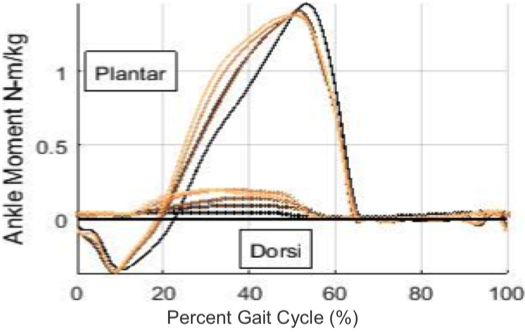Kinematic and Kinetic Analysis of a Transtibial Biarticular Prosthesis
Presented at VA Young Investigators Symposium, 2016
Downloads: abstract, slides
Introduction
There are a number of biomechanical differences between amputee gait and healthy gait. These differences can lead to secondary conditions such as back pain and osteoarthritis related knee pain [1]. The lack of gastrocnemius (GAS) muscle for example is associated with elevated activation of knee and hip flexors and decreased ankle push-off power. To improve amputee gait we are developing a foot-ankle prosthesis with a clutched spring that spans both the knee and ankle joints. We hypothesize that this spring element can emulate GAS function and reduce gait compensations in amputee walking.
Methods
We built a prototype of the Biarticular Prosthesis (BP), which features a ratchet-clutched spring that attaches above the knee (with a rigid thigh cuff) and below the ankle. The ratchet mechanism ensured the spring rest length was minimized so as to maximize spring force production, while allowing kinematics to drive the timing rather than software. A strain gauge in the pylon detected heel strike. A load cell was attached in series to the spring to measure spring force. One transtibial amputee subject walked on an instrumented treadmill while wearing the BP. Walking trials were collected using different BP spring stiffnesses, of 1.85 N/mm, 3.7 N/mm, 10.5 N/mm, and Stiffest (unknown k-value). 3D motion capture data, ground reaction forces, spring on/off signal, and spring force data were collected at 120 Hz (video) and 1200 Hz (analog data).
OpenSim [2] was used to compute joint kinematics and joint torques, using a previously developed generic unilateral transtibial amputee model [3]. The model has 21 degrees of freedom and 80 muscles of the lower body. Inverse Dynamics was performed twice for each trial: first without prescribing the experimental spring forces, and then with prescribing spring force to the model in a similar manner to the ground reaction forces. The difference between these two accounts for the BP contribution to joint torques. This novel approach to calculating BP spring contribution was verified by calculation in MATLAB. Knee and Ankle torque contributions were calculated using the equation , where is the moment arm provided by OpenSim and is the experimentally measured spring force.
Results and Discussion

Figure 1. BP contribution to total ankle moment. The solid lines are total ankle moment, and the hatched lines show BP contribution. Spring stiffness increases from dark to light color.
The MATLAB calculations show that the dual inverse dynamics method successfully calculated the BP contribution to individual joint torques. As spring stiffness increased, the BP contribution to the ankle moment increased (Figure 1). The BP contributed up to 33% of ankle torque. The BP spring
started producing force at 15-20% of the gait cycle, slightly earlier than GAS (Figure 1). The BP force is counterproductive in that early region—the BP provides a plantar flexion torque while the ankle overall has a dorsiflexion moment.
Current analysis shows total knee moment 3-5 times larger than literature [4], on both the ipsilateral and contralateral legs. Similarly elevated knee moment is also present in the prescribed foot trials, but only on the contralateral side. More analysis is needed to understand the BP’s role at the knee.
Additionally, as the spring stiffness of the BP was increased, the knee extension in late stance decreased. Despite producing less force and moment than the physiological GAS, the spring force pulls the knee and causes it to remain in flexion.
Conclusion
The dual inverse dynamics method is a valid and useful tool for analysis of the BP contribution to joint moments. This method can be expanded to more easily understand the device’s effect on other joints, such as the hip. Further investigation is needed to understand the observed elevated knee moment. Next steps are to continue study of the BP with additional subjects.
